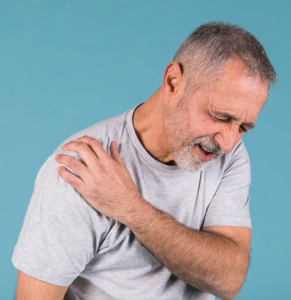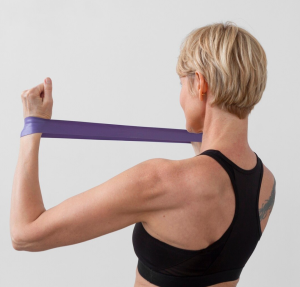The rotator cuff is a group of muscles and tendons that surround the shoulder joint, keeping the head of the upper arm bone firmly within the shallow socket of the shoulder. Unfortunately, a rotator cuff tear injuries are fairly common and increase in occurrence with age.
What causes a rotator cuff tear?
- Accident/trauma – Ex. Falling, broken collarbone, dislocated shoulder
- Bone spurs – Bony growths can form on the top of your shoulder bone. Consequently, these bone spurs rub against your tendon when you lift your arm. This shoulder impingement creates friction between your bone and tendon. Eventually, a partial or complete tear may occur
- Decreased blood flow – Blood flow to your rotator cuff decreases as you get older. Your muscles and tendons need a healthy blood supply to repair themselves. If blood doesn’t nourish your tendons, they can tear
- Overuse – Repetitive shoulder movements during sports such as Recreational and professional athletes who play baseball, softball and tennis or are part of a rowing crew. or on the job such as carpenting, mechanics, painter can stress your muscles and tendons, causing a tear
What are the symptoms?
- Difficulty, pain and weakness caused by raising, lowering or rotating your arm
- Popping, clicking or crackling sounds or sensations when moving your arm in certain positions
- Shoulder pain that worsens at night or when resting your arm
- Shoulder weakness and struggling to lift items
How is it treated?
Initially, conservative, or nonsurgical, treatments will be used for a rotator cuff injury. These treatments may include:
- An arm sling and rest to give your shoulder time to heal. Additionally, you may need to modify activities and stop certain work or sports for a period of time
- Nonsteroidal anti-inflammatory drugs (NSAIDs) may help minimize pain and swelling
- Physical therapy to learn strengthening and stretching exercises
- Steroid injections to help ease pain and swelling.
Rotator Cuff Tears and Physiotherapy
Firstly, physiotherapy (PT) is a great way to get back strength and movement after an injury. It includes things like exercise, ice, heat, massage, and equipment to help return your shoulder back to its normal range of motion and strength. Unless the injury is severe, physiotherapy is the typical starting point for a rotator cuff tear.
Your physical therapist will ask questions about your life and the things you do. Then, they’ll do some tests to learn more about your pain and function. Ultimately, the goal will be to help you:
- Get back your range of motion
- Learn exercises to strengthen your shoulder muscles
- Improve the way you sit and stand (your posture) to help reduce pain
- Find a way to sleep that doesn’t hurt your shoulder
- Learn to carry objects safely
- Use ice or heat to ease the pain
- Understand why you need to keep moving
- Find ways to do things so that they don’t hurt your shoulder
- Return to your regular activities (be patient — this can take a while)
Furthermore, if your injury does require surgery, PT is an integral part of post-operative rehabilitation. Overall, It’s the same idea — to improve strength and movement and get back to regular life. The therapist will show you how not to injure your shoulder
again after surgery. Then, they will progressively increase your strength, mobility, and functional abilities.
What do I do if I have shoulder pain?
At PhysioNow, we will help you to recover, pay attention to your pain and find best way to heal your injured shoulder and keep it as strong as possible. Book your first appointment with PhysioNow today!

